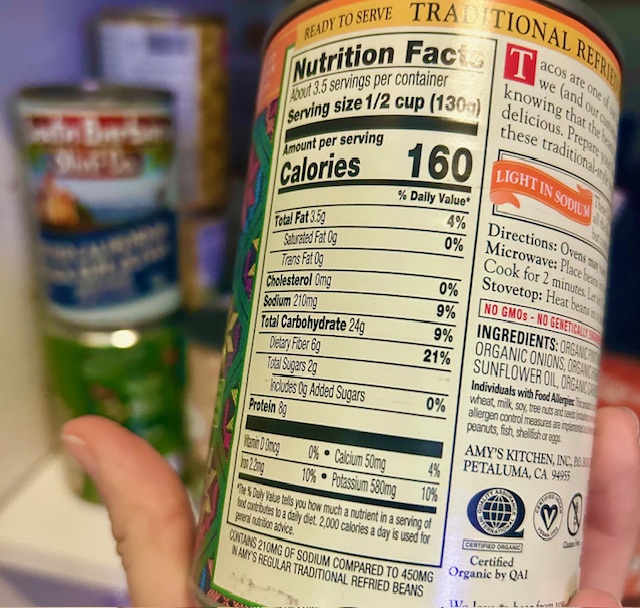Reading Food Labels
As someone who has been dealing with food allergies and intolerances for a very long time, I had to learn how to read food labels in a way that I realize I may take for granted. For those of you who have recently developed a food allergy, just discovered an intolerance, or have a child with one of the above ailments, reading food labels and knowing what to look for may be very foreign. I am hoping to be helpful in your journey to gain greater control and knowledge over what you are putting into your body and the bodies of those you feed!
Let’s Start with the Basics
I don’t want to take for granted that everyone knows some of the basics of food labels. So I want to start with a couple truisms across all labels.
First, serving sizes are a way to track calories and macronutrients of a food item, but they are NOT actual reasonable portions. If you have ever tried to have a serving of pasta with a serving of sauce, you will notice that the two measurements don’t match up. That is because serving sizes are manipulated to make a product appear more “healthy” or less calorically dense depending on the goals of the brand. Want to make an unhealthy treat seem more healthy? Make the serving size smaller so that the saturated fat number is smaller. But the serving size is smaller than any human would actually ever consume of the item! I am not going to tell anyone how to eat or diet, but in my opinion, serving sizes are helpful for very little and I try not to get hung up on that part of the label.
Second, the ingredients list starts with the highest percentage ingredient and decreases in quantity as the list goes on. This is helpful for people with food sensitivities who might be willing to eat something with just a small amount of what they are sensitive too. In these cases, if it is last or near last on the list, that way be okay for the person with mild sensitivity. Of course if it is only a couple ingredients…use your common sense (like potatoes chips with just potatoes and an oil…the oil is still a significant ingredient if you have a sensitivity to it.).
Common Allergens and Intolerances I Am Familiar With

Dairy
There are different parts of dairy that people can have issues with. People can be allergic to one or multiple proteins within dairy or be intolerant to the sugar (lactose intolerance). If you avoid dairy in general things to look for in the ingredients list would include anything with the milk proteins in the name i.e. whey protein, casein or the isolated sugar lactose. Once you start reading labels it is shocking how common dairy is in our food. A lot of foods include lactose as a binding agent… like broth packets or certain flavors of potato chips! The product might not even suggest dairy is in it if you don’t read the label. Some candy even has milk that is fruity in flavor.
Soy
Soy is another really prevalent ingredient in foods, particularly processed foods, and is a sneaky little devil. Soy has really become a filler saturating out foods (in the United States in particular) which is pretty unfortunate considering it is a phyto-estrogen which means it is disrupting both male and female hormones and most of us are fully unaware they are dosing with hormones with each meal.
Soy takes a lot of forms in products to include soy flour, soy protein, soy protein isolate which are easier to see. Soy oil can be a bit more sneaky (at tends to be a culprit of sensitivity). Soy oil is sometimes listed as this directly, but other times it is listed as “vegetable oil” and then you have to check the parentheses for what oils are being considered in this wider umbrella term of vegetable oil. If you (or maybe an infant you are nursing) is highly allergic to soy, even soy lecithin, which is an emulsifier and often at the end of the ingredients list (meaning of a very small quantity) can cause a reaction. This is probably the toughest ingredient to avoid because this is by far the most common emulsifier in our food nowadays.

Food Labels Seem Scary
Once you start digging in to food labels, what you find can be a bit scary. Ingredients you did not know about have probably been in the foods that you eat regularly. But there is a power in knowing. Once you know what to look for, even just know to start looking, you can start to track how foods make you feel and what ingredients may be causing you discomfort or inflammation.
If you are severely allergic or sensitive to one of the ingredients that is super prevalent in so many foods, a diet of whole foods and more produce might be a viable solution. Single ingredient foods are really the best way to avoid problematic ingredients. This is EXACTLY why I started cooking my food from scratch (when I can) and having a single ingredient forward diet that is produce heavy and using quality ingredients.
I am a firm believer that your food should be catered to you and your body’s needs. That is what has brought me to this point in my cooking journey and why I wanted to share it! Cleaner recipes and ingredients are within reach, I hope my blog is helpful as you progress on the journey of your own.



Leave a Reply